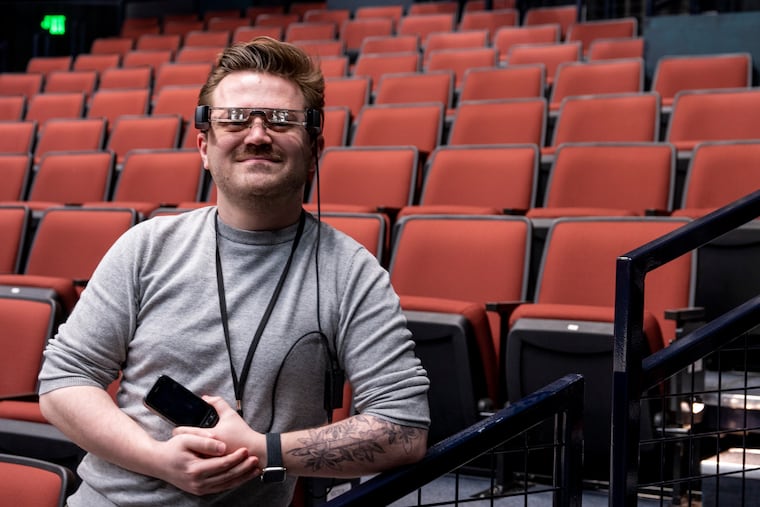The Arden’s new AI glasses bring subtitles to the theater
A.I. caption glasses are available at just two theaters in the country. Both are in the Philly area.

One quiet afternoon in February, I put on futuristic eyewear to see a matinee show of Ladysitting in Old City. The wide-frame gear earned some curious looks, but this special pair isn’t meant to be fashionable — it’s designed to be worn in the dark for theatergoers who need captions for plays and musicals.
Smart caption glasses represent new technology that precious few audiences can access. Dialogue and stage directions float in the frame so users can see the action on stage without looking away to read. Philadelphia’s Arden Theatre is the second theater in the country offering them, following People’s Light in Malvern, where the A.I.-assisted accessibility tool has successfully attracted deaf and hard-of-hearing communities after launching in 2019.
Theaters typically offer closed captions at select performances, with a screen on the side of the stage and a staffer behind the scenes ensuring the text matches up with the action; others offer smartphone apps or other devices that require users to look down. Caption glasses prevent the need for frequent head swiveling between stage and screen, and allow theaters to offer captions for most performances.
It’s a personalized experience where the user can adjust the placement, size, and color of the text with the handheld device that hangs from a lanyard. The dozen glasses now available at Arden are the latest version made by Epson, upgraded with a sleek black design, more comfortable distribution of weight on the wearer’s face, and a touchscreen device.
Smart caption glasses were first offered at London’s Royal National Theatre in 2018. Lisa Sonneborn, director of media arts and culture at Temple University’s Institute on Disabilities, was instrumental in bringing the technology to the United States.
“One of the main barriers to being able to attend the theater is the availability of captioning,” said Sonneborn. “It’s really an always-on solution.”
The key is timing: Other caption devices often lag behind the action onstage, leading to delayed reactions. Sonneborn once attended a show with a glasses user at People’s Light and after a punchline, the woman laughed along with the audience. It was a pleasant surprise. “She said, ‘I just laughed at the same time everyone else laughed — I never thought that could happen to me,” Sonneborn recalled. “That’s the magic of the glasses, that people can really have the same experience as their friends and family members.”
The process of setting up glasses for each production takes about a week. For the first few performances, a staffer tracks the timing of each line delivery as well as lighting and audio cues. During the show, the glasses respond to those cues and pick up dialogue from a microphone placed above the middle of the stage. The script feeds into a software called Sveltext, which then pairs with an app called WatchWord that matches the text and the glasses captions. After that, the captions essentially run by themselves.
As the technology continues to develop, Sonneborn hopes one day captions can be available in different languages. She is planning to bring the glasses to more theaters.
Temple and Arden Theatre received a grant of $30,000 from the Virginia Brown Martin Fund to cover the cost of the glasses (each pair costs about $1,000) and software licenses. For theatergoers, though, they are free to use with admission. Arden says they’re available on a first-come, first-served basis and attendees can request them when they arrive.
“The biggest challenge for us is going to be introducing our audiences to it, getting them comfortable, and convincing them that this is a useful tool for them,” said Arden general manager Clayton Tejada.
Tejada called Ladysitting, a play about a 101-year-old woman and her caregiving family, a “perfect production” for the rollout, due to the small cast and static set. Setting up glasses for larger shows and musicals will be more complex.
In the dark of the theater during the matinee, I fiddled with the settings throughout the show, seemingly without disrupting the experience for my neighbors. The tech was easy to navigate, but the gear was clunky and awkward to wear — it’s certainly not recommended to use anywhere but your seat.
I experimented with where I wanted to see the captions; above the stage, to the right, or on the head of the person seated in front of me. Like any caption experience, there were slight differences between what was written and what was said, but that’s what happens with live theater — improvisation.
The only lingering question I had as I got teary during this emotional play about love, loss, and family: Are these things waterproof?